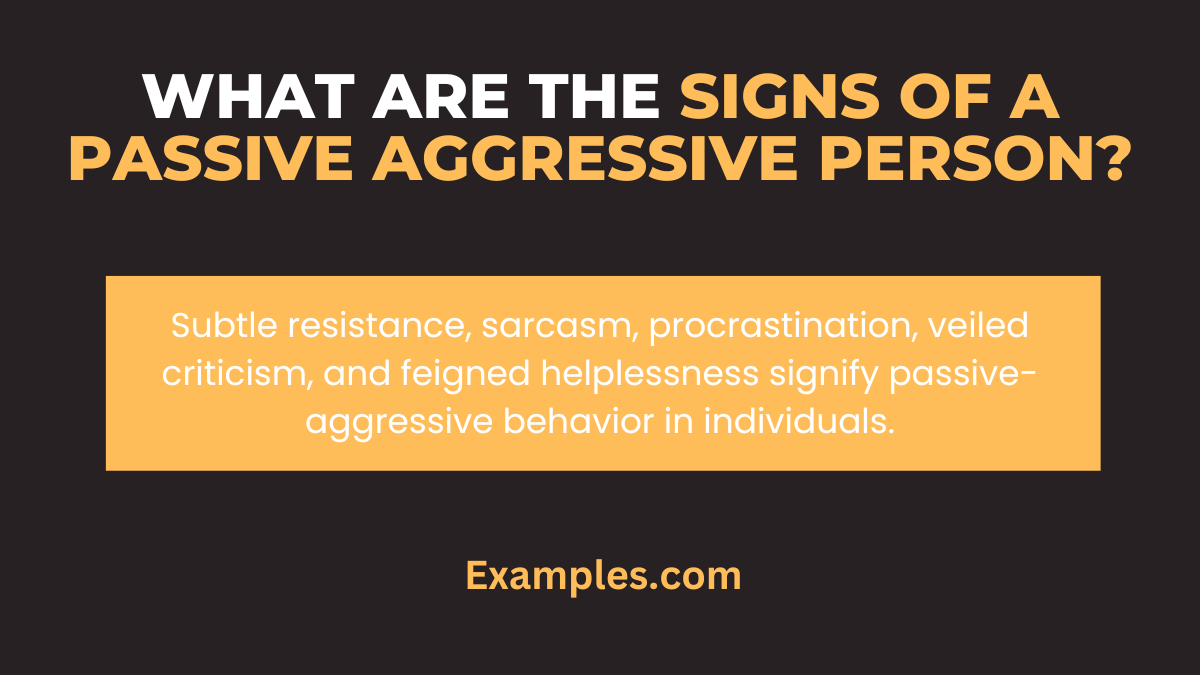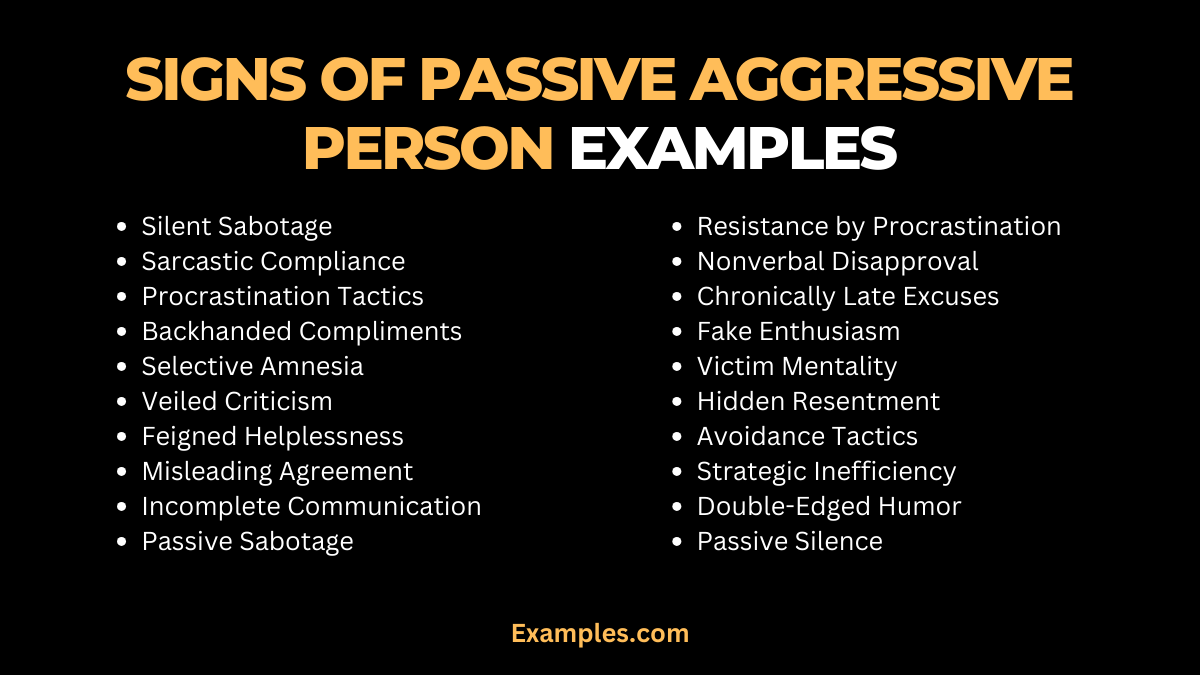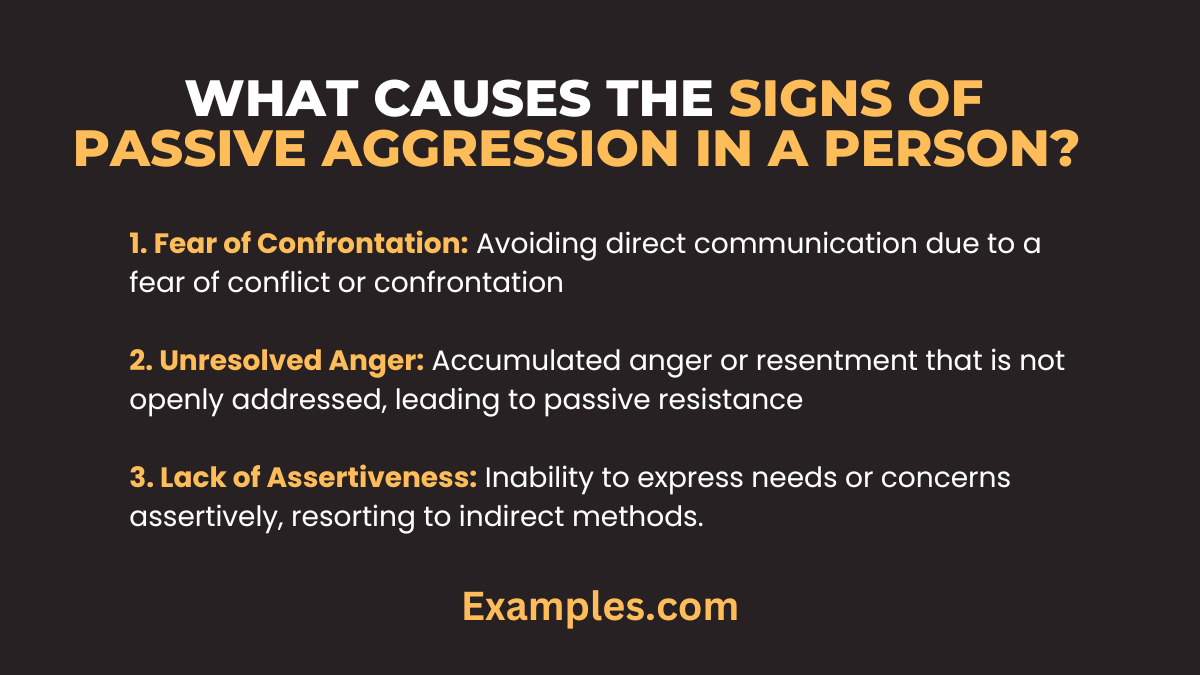19+ Signs of Passive Aggressive Person Examples
Navigating the intricacies of human behavior involves understanding passive-aggressive communication styles. In this comprehensive guide on signs of a passive-aggressive person, we delve into vivid examples illuminating the nuances of this behavior. Uncover the subtle yet impactful indicators that signify passive aggression, empowering you with valuable insights. Learn how these communication examples manifest in daily interactions, and gain practical tips to foster healthier connections in both personal and professional spheres. Elevate your awareness and enhance your communication prowess with this insightful exploration.
What are the Signs of Passive Aggressive Person?

A passive-aggressive person demonstrates indirect resistance to the demands of others, expressing negative feelings covertly. In simpler terms, this behavior involves a masked form of hostility or resistance. Recognizing signs of a passive-aggressive individual is crucial for effective communication. Understanding these indicators empowers individuals to navigate relationships more smoothly, fostering an environment of open dialogue and cooperation. Delve into the nuances of passive-aggressive traits to enhance your interpersonal communication skills and build healthier connections.
20 Signs of Passive Aggressive Person Examples

Explore the clandestine world of passive-aggressive behavior with our insightful guide on the 20 signs of a passive-aggressive person. Delve into vivid examples that illuminate the nuances of this subtle yet impactful communication style. Uncover practical tips on handling these situations, enhancing your interpersonal skills and fostering healthier connections.
- Silent Sabotage: When a colleague consistently “forgets” to share vital information, affecting team progress.
- Sarcastic Compliance: Responding to a request with apparent agreement but infusing sarcasm, creating tension.
- Procrastination Tactics: Delaying tasks intentionally to express frustration or resistance without direct confrontation./li>
- Backhanded Compliments: Giving compliments with a hidden critique, leaving the recipient uneasy.
- Selective Amnesia: Pretending to forget agreements or promises to avoid fulfilling commitments.
- Veiled Criticism: Expressing disapproval through subtle hints and insinuations.
- Feigned Helplessness: Pretending incapability to manipulate others into taking charge.
- Misleading Agreement: Agreeing to avoid conflict but undermining the decision covertly.
- Incomplete Communication: Deliberately withholding information to create confusion or frustration.
- Passive Sabotage: Undermining collective efforts without overt confrontation.
- Resistance by Procrastination: Deliberate delays in work to resist authority or express dissatisfaction./li>
- Nonverbal Disapproval: Expressing disagreement through body language rather than direct communication.
- Chronically Late Excuses: Consistently arriving late with inventive excuses to display resistance.
- Fake Enthusiasm: Masking disinterest with a false display of enthusiasm.
- Victim Mentality: Adopting a victim stance to manipulate sympathy and avoid responsibility.
- Hidden Resentment: Nursing grievances silently instead of addressing issues directly.
- Avoidance Tactics: Intentionally dodging conversations or confrontations to maintain control.
- Strategic Inefficiency: Purposely performing tasks inefficiently to convey displeasure.
- Double-Edged Humor: Making jokes that carry a sting, subtly criticizing others.
- Passive Silence: Using silence as a weapon to convey disapproval or disagreement.
Signs of Passive Aggressive Person Examples for Students
Unlock the dynamics of passive-aggressive behavior in a student context. Our guide sheds light on the subtle signs, providing valuable insights for educators, parents, and students alike. Understand the impact of passive aggression in academic settings and equip yourself with effective communication strategies to foster a positive learning environment.
- Unresponsiveness in Group Work: A student deliberately avoids contributing or responds minimally in group projects, causing frustration among peers.
- Selective Cooperation: Choosing when to follow instructions, exhibiting passive resistance to authority figures.
- Incomplete Collaboration: Withholding crucial information from study groups to subtly hinder collective success.
- Task Delay Tactics: Delaying submissions under the guise of perfectionism or external challenges.
- Masked Disagreement: Expressing dissent through nonverbal cues instead of openly discussing concerns.
Signs of Passive Aggressive Person Examples for Employees
Navigate workplace dynamics by understanding the signs of passive-aggressive behavior among employees. This guide offers practical insights for employers and colleagues, empowering them to foster a positive work environment. Learn to identify and address passive aggression effectively, enhancing teamwork and productivity.
- Missed Deadlines with Excuses: An employee consistently fails to meet deadlines, providing creative excuses to deflect responsibility.
- Undermining Office Policies: Subtly challenging established procedures without direct confrontation.
- Indirect Resistance to Feedback: Reacting passively to constructive criticism, avoiding direct acknowledgment or improvement.
- Office Gossip Tactics: Engaging in subtle gossip to undermine colleagues or create discord in the workplace.
- Task Delegation Sabotage: Sabotaging delegated tasks through intentional mistakes or oversights.
How do you know that a Person Exhibits Signs of Passive Aggressive?
Understanding passive-aggressive behavior involves recognizing subtle indicators that may not be overtly expressed. Here’s a guide to help you identify signs of passive-aggressive traits:
- Indirect Communication:
- Communicates indirectly, making it challenging to discern true feelings or intentions.
- Subtle Resistance:
- Expresses resistance or dissent in a concealed manner, avoiding direct confrontation.
- Veiled Criticism:
- Provides disguised criticism or negative feedback through subtle remarks or gestures.
- Procrastination Tactics:
- Delays tasks intentionally to express frustration or resistance without explicit communication.
- Selective Cooperation:
- Chooses when to comply with requests, demonstrating resistance to authority figures.
What Causes the Signs of Passive Aggression in a Person?

Passive-aggressive behavior can stem from various underlying factors. Here are the key causes:
- Fear of Confrontation:
- Avoiding direct communication due to a fear of conflict or confrontation.
- Unresolved Anger:
- Accumulated anger or resentment that is not openly addressed, leading to passive resistance.
- Lack of Assertiveness:
- Inability to express needs or concerns assertively, resorting to indirect methods.
- Control Issues:
- Seeking to maintain control or power dynamics through subtle manipulation.
- Insecurity:
- Feelings of inadequacy or insecurity that manifest in passive-aggressive tendencies.
How To Improve the Signs of a Passive Aggressive in a Person?
Addressing passive-aggressive behavior involves fostering open communication and addressing underlying issues. Here’s how to improve such signs:
- Encourage Open Dialogue:
- Create a safe space for open communication, encouraging individuals to express thoughts and concerns directly.
- Provide Constructive Feedback:
- Offer constructive feedback in a supportive manner, helping individuals understand and address their behavior.
- Teach Assertiveness Skills:
- Conduct workshops or training sessions to enhance assertiveness skills, enabling individuals to express themselves confidently.
- Promote Conflict Resolution:
- Encourage the use of healthy conflict resolution strategies to address issues proactively.
- Seek Professional Help:
- In cases of deep-seated issues, recommend seeking professional counseling or therapy for personalized assistance.
How to Overcome Signs of a Passive Aggressive in a Person?
By incorporating these five key points into interpersonal dynamics, individuals and teams can overcome signs of passive-aggressive behavior, leading to more positive and productive relationships.
- Understanding Passive-Aggressive Behavior: Recognizing signs of passive-aggressive behavior is the first step. This includes subtle indicators like procrastination, sarcasm, and veiled criticism. Develop a keen awareness to identify these traits in both verbal and nonverbal communication.
- Open Communication Channels: Encourage open dialogue by fostering an environment where individuals feel comfortable expressing their thoughts and concerns. Establishing clear lines of communication helps in addressing issues directly, reducing the likelihood of passive-aggressive responses.
- Promoting Constructive Feedback: Create a culture of constructive feedback to address passive-aggressive tendencies. Encourage individuals to express their opinions directly and provide feedback in a positive and solution-oriented manner. This helps in building a more transparent and collaborative atmosphere.
- Building Empathy and Understanding: Promote empathy by encouraging individuals to understand each other’s perspectives. Passive-aggressive behavior often stems from unexpressed emotions or misunderstandings. Cultivating a culture of empathy can mitigate these issues and foster healthier relationships.
- Conflict Resolution Strategies: Equip individuals with effective conflict resolution strategies. Provide training on addressing conflicts directly, employing active listening, and finding mutually beneficial solutions. Developing these skills empowers individuals to navigate disagreements without resorting to passive-aggressive behavior.
In conclusion, understanding the signs of a passive-aggressive person is pivotal for fostering healthier communication. This comprehensive guide illuminates the nuances through vivid examples, empowering readers to navigate challenging interactions effectively. By recognizing, addressing, and overcoming passive-aggressive behavior, individuals can build stronger, more harmonious relationships both personally and professionally.



